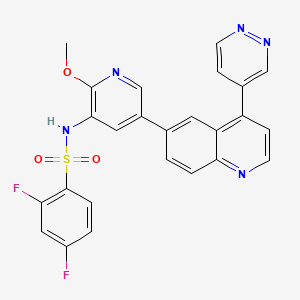Drug Information
Drug (ID: DG01551) and It's Reported Resistant Information
| Name |
Omipalisib
|
||||
|---|---|---|---|---|---|
| Synonyms |
Omipalisib; 1086062-66-9; GSK2126458; GSK-2126458; GSK 2126458; 2,4-difluoro-N-(2-methoxy-5-(4-(pyridazin-4-yl)quinolin-6-yl)pyridin-3-yl)benzenesulfonamide; 2,4-difluoro-N-[2-methoxy-5-(4-pyridazin-4-ylquinolin-6-yl)pyridin-3-yl]benzenesulfonamide; UNII-1X8F5A3NA0; 2,4-Difluoro-N-[2-methoxy-5-[4-(4-pyridazinyl)-6-quinolinyl]-3-pyridinyl]benzenesulfonamide; 1X8F5A3NA0; Omipalisib (GSK2126458, GSK458); C25H17F2N5O3S; 2,4-difluoro-N-(2-(methyloxy)-5-(4-(4-pyridazinyl)-6-quinolinyl)-3-pyridinyl)benzenesulfonamide; GSK-212; Omipalisib [USAN:INN]; GSK458; GSK 212; 2,4-difluoro-N-{2-(methyloxy)-5-[4-(4-pyridazinyl)-6-quinolinyl]-3-pyridinyl}benzenesulfonamide; Omipalisib (USAN/INN); MLS006011258; Omipalisib; GSK2126458; SCHEMBL623194; GTPL8974; Omipalisib (GSK2126458); CHEMBL1236962; CHEBI:95093; DTXSID10148604; EX-A003; GSK-458; SYN1126; 3l08; HMS3656D09; AOB87781; BCP02252; BDBM50145416; MFCD16038929; NSC764092; NSC800807; s2658; ZINC43208634; AKOS015904655; CCG-264973; CS-0085; DB12703; NSC-764092; NSC-800807; QC-7243; SB16572; NCGC00250408-01; NCGC00250408-05; AC-28458; AS-16266; Benzenesulfonamide, 2,4-difluoro-N-(2-methoxy-5-(4-(4-pyridazinyl)-6-quinolinyl)-3-pyridinyl)-; GSK2126458 (GSK458); HY-10297; SMR004703011; FT-0669061; SW219502-1; X7449; A25172; D10718; GSK-2126458;GSK 2126458; Omipalisib; J-507217; Q27088179; N-[2-Methoxy-5-[4-(4-pyridazinyl)-6-quinolinyl]-3-pyridinyl]benzenesulfonamide; ZIG
Click to Show/Hide
|
||||
| Indication |
In total 2 Indication(s)
|
||||
| Structure |

|
||||
| Target | Hepatitis C virus Non-structural 5A (HCV NS5A) | POLG_HCV1 | [2] | ||
| Click to Show/Hide the Molecular Information and External Link(s) of This Drug | |||||
| Formula |
6
|
||||
| IsoSMILES |
COC1=C(C=C(C=N1)C2=CC3=C(C=CN=C3C=C2)C4=CN=NC=C4)NS(=O)(=O)C5=C(C=C(C=C5)F)F
|
||||
| InChI |
InChI=1S/C25H17F2N5O3S/c1-35-25-23(32-36(33,34)24-5-3-18(26)12-21(24)27)11-17(13-29-25)15-2-4-22-20(10-15)19(7-8-28-22)16-6-9-30-31-14-16/h2-14,32H,1H3
|
||||
| InChIKey |
CGBJSGAELGCMKE-UHFFFAOYSA-N
|
||||
| PubChem CID | |||||
| ChEBI ID | |||||
| TTD Drug ID | |||||
| DrugBank ID | |||||
Type(s) of Resistant Mechanism of This Drug
Drug Resistance Data Categorized by Their Corresponding Diseases
ICD-02: Benign/in-situ/malignant neoplasm
| Drug Sensitivity Data Categorized by Their Corresponding Mechanisms | ||||
|
|
||||
| Key Molecule: Platelet-derived growth factor receptor alpha (PDGFRA) | [1] | |||
| Molecule Alteration | Missense mutation | p.D842V (c.2525A>T) |
||
| Sensitive Disease | Solid tumour/cancer [ICD-11: 2A00-2F9Z] | |||
| Experimental Note | Revealed Based on the Cell Line Data | |||
| In Vitro Model | MCF10A cells | Breast | Homo sapiens (Human) | CVCL_0598 |
| Ba/F3 cells | Colon | Homo sapiens (Human) | CVCL_0161 | |
| Experiment for Molecule Alteration |
qRT-PCR | |||
| Experiment for Drug Resistance |
Presto blue assay | |||
| Mechanism Description | PDGFRA Y288C induces constitutive phosphorylation of Akt, ERK1/2, and STAT3. PDGFRA Y288C is resistant to PDGFR inhibitors, such as crenolanib, but sensitive to PI3K/mTOR and MEK inhibitors, such as omipalisib, consistent with pathway activation results. | |||
| Key Molecule: Platelet-derived growth factor receptor alpha (PDGFRA) | [1] | |||
| Molecule Alteration | Missense mutation | p.Y288C (c.863A>G) |
||
| Sensitive Disease | Solid tumour/cancer [ICD-11: 2A00-2F9Z] | |||
| Experimental Note | Revealed Based on the Cell Line Data | |||
| In Vitro Model | MCF10A cells | Breast | Homo sapiens (Human) | CVCL_0598 |
| Ba/F3 cells | Colon | Homo sapiens (Human) | CVCL_0161 | |
| Experiment for Molecule Alteration |
qRT-PCR | |||
| Experiment for Drug Resistance |
Presto blue assay | |||
| Mechanism Description | PDGFRA Y288C induces constitutive phosphorylation of Akt, ERK1/2, and STAT3. PDGFRA Y288C is resistant to PDGFR inhibitors, such as crenolanib, but sensitive to PI3K/mTOR and MEK inhibitors, such as omipalisib and trametinib, consistent with pathway activation results. | |||
| Key Molecule: Platelet-derived growth factor receptor alpha (PDGFRA) | [1] | |||
| Molecule Alteration | Missense mutation | p.V561D (c.1682T>A) |
||
| Sensitive Disease | Solid tumour/cancer [ICD-11: 2A00-2F9Z] | |||
| Experimental Note | Revealed Based on the Cell Line Data | |||
| In Vitro Model | MCF10A cells | Breast | Homo sapiens (Human) | CVCL_0598 |
| Ba/F3 cells | Colon | Homo sapiens (Human) | CVCL_0161 | |
| Experiment for Molecule Alteration |
qRT-PCR | |||
| Experiment for Drug Resistance |
Presto blue assay | |||
| Drug Sensitivity Data Categorized by Their Corresponding Mechanisms | ||||
|
|
||||
| Key Molecule: Serine/threonine-protein kinase B-raf (BRAF) | [2] | |||
| Molecule Alteration | Missense mutation | p.V600K (c.1798_1799delGTinsAA) |
||
| Sensitive Disease | Melanoma [ICD-11: 2C30.0] | |||
| Experimental Note | Revealed Based on the Cell Line Data | |||
| In Vitro Model | A375 cells | Skin | Homo sapiens (Human) | CVCL_0132 |
| Experiment for Molecule Alteration |
Western blotting analysis | |||
| Experiment for Drug Resistance |
CellTiter-Glo assay | |||
| Mechanism Description | The missense mutation p.V600K (c.1798_1799delGTinsAA) in gene BRAF cause the sensitivity of Omipalisib by unusual activation of pro-survival pathway | |||
| Key Molecule: Serine/threonine-protein kinase B-raf (BRAF) | [2] | |||
| Molecule Alteration | Missense mutation | p.V600E (c.1799T>A) |
||
| Sensitive Disease | Melanoma [ICD-11: 2C30.0] | |||
| Experimental Note | Revealed Based on the Cell Line Data | |||
| In Vitro Model | A375 cells | Skin | Homo sapiens (Human) | CVCL_0132 |
| Experiment for Molecule Alteration |
Western blotting analysis | |||
| Experiment for Drug Resistance |
CellTiter-Glo assay | |||
| Mechanism Description | The missense mutation p.V600E (c.1799T>A) in gene BRAF cause the sensitivity of Omipalisib by unusual activation of pro-survival pathway | |||
References
If you find any error in data or bug in web service, please kindly report it to Dr. Sun and Dr. Zhang.
